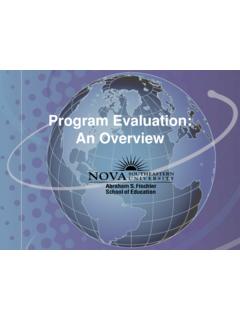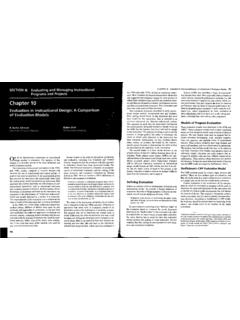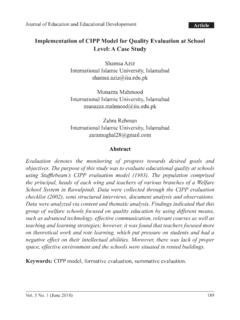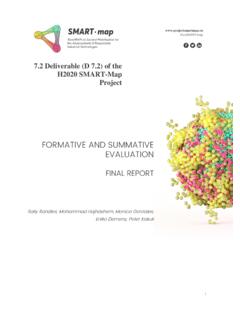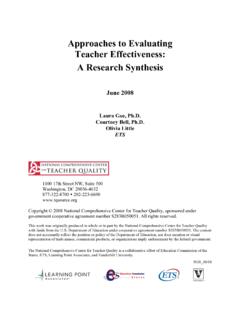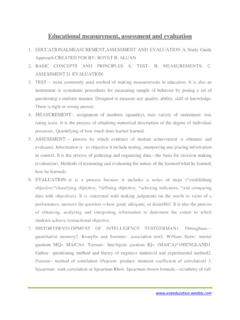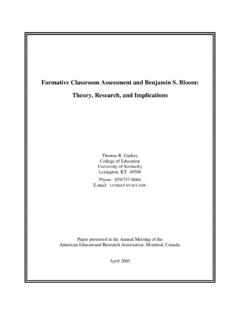Transcription of How to evaluate the programme - World Health Organization
1 How to evaluate the programme44: Impact assessment4 How to evaluate the Planning the evaluation ..1214 .1 ..1224 .1 .. Choosing the evaluation methods ..1234 .2 ..1244 .2 ..1244 .2 ..1284 .2 ..1294 .2 .. Dissemination and feedback ..132 Summary..135 References..136121D rinking and D riving: a roa d safet y manual4 | How to evaluate the programmeMonitoring and evaluation of any programme or intervention is vital to determine whether it works, to help refine programme delivery, and to provide evidence for continuing support of the programme . evaluation will not only provide feedback on the effectiveness of a programme but will also help to determine whether the programme is appropriate for the target population, whether there are any problems with its implementation and support, and whether there are any ongo-ing concerns that need to be resolved as the programme is implemented.
2 This module describes the process of developing and conducting an evaluation of a drinking and driving programme . It is divided into three key Planning the evaluation : This important initial stage involves collecting data, in a baseline study, to assess the situation before going on to develop the pro-gramme. Based on the information collected, it is then necessary to define the aims of an evaluation , and to consider the different types of evaluation methods that could be used for your Choosing the evaluation methods: Once the type of evaluation has been determined, there are different methods that can be applied to carry out an evaluation .
3 This section describes the different study types possible, explaining the advantages and disadvantages of each type of method. It outlines the types of performance indicators that can be used to measure the success of a programme . This section also briefly describes how to conduct an economic evaluation , and provides guidance on calculating sample size. Dissemination and feedback: This section describes how to feed the result of an evaluation back into the planning and implementation stages, as well as ways that the results of an evaluation can be shared with different interested Planning the evaluation The process of designing and implementing a drinking and driving programme was covered in Module 3.
4 Work carried out prior to implementation should ensure that the programme is clearly defined and that it is implemented in a consistent and standardized way. It is far easier to evaluate the impact of a complete, well-planned and executed programme than one that is implemented in an inconsistent way. It is essential that the evaluation framework is developed and implemented along-side the proposed programme . Thus, this work would be carried out by the working group as they develop the action plan for the programme (see Module 3). Baseline measures need to be collected before the intervention is put in place so that change in such measures over time may be gauged.
5 122M odule 4: How to evaluate the p rogra mmeThe type of evaluation to be conducted will depend on a number of factors. These include the aims of the evaluation itself, as well as the objectives of the programme being evaluated. The type of methodolog y chosen may also depend on resource constraints. Aims of evaluationThe aims of the programme will determine how best to carry out the evaluation . The evaluation will focus on assessing the extent to which the programme objectives have been met, and may have one or more aims. For example, an evaluation of a drink-ing and driving legislation and increased enforcement programme may primarily be aimed at determining whether drinking and driving rates have reduced as a result of the programme .
6 However, secondary aims may include determining whether the enforcement has increased, whether training of police is effective, and whether the programme is acceptable to the stakeholders. The evaluation in this case needs to be multifaceted. The breadth of an evaluation will always be limited by the resources available, but note that a well-designed, simple evaluation can be as powerful as a more complex and costly Types of evaluationEvaluation may take several forms, and one or more may be appropriate, depending on the aims of the specific programme to be evaluated.
7 Process evaluationRather than measuring change in outcomes, this aspect of evaluation examines whether the programme was carried out as planned. This involves creating a list of indicators that need to be measured, depending on the aims of the programme . The results will help to identify the strengths and weaknesses of the programme , and where improvements may be made. For example, in a media campaign designed to reduce drinking and driving, a process evaluation may ask these sorts of questions:Have the campaign products (posters, billboard, radio and television spots) been pre-tested?
8 How often were the campaign advertisements run?How many people saw them?Was the target group being reached?If the intervention involves enforcement of drinking and driving legislation:Is there noticeable enforcement by police?Are the police supportive of the campaign? 123D rinking and D riving: a roa d safet y manual4 | How to evaluate the programmeIs the penalty sufficient to change behaviour?Are people able to circumvent the process (for example, using bribery)?Process evaluations are what are known as formative . That is, the enquiries car-ried out are designed to provide information to guide programme improvement (1).
9 For example, it may be considered important to determine whether the TV adverts shown as part of a drinking and driving programme are appropriate do they adequately address the issue, does the behaviour portrayed reflect drinking customs in the region where the adverts will be seen?Impact assessmentThis will determine whether the programme has brought about a change. The impact, or programme effect, refers to a change in the target population that has been brought about by the programme that is, a change that would not have occurred if the programme had not happened (1).
10 For example, if the programme involved airing television advertisements on drinking and driving, the impact assess-ment might examine whether people who had seen the advertisements believe that there is a good chance that they will be stopped and breathalysed by the police if they drink and drive. Unlike a process evaluation , this would tend to take place at the end of a programme , as the focus would be on the evaluationThis is where the outcomes are measured to see if the programme was successful. Are less people now drinking and driving than before? Have road crashes involving alco-hol been reduced?










